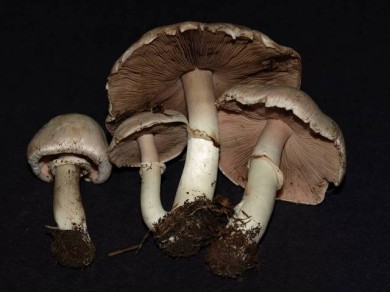Past Mushrooms of the Month
Lawn Agaricus (by Bob Sellers)
Mushroom of the Month: November, 2013
 This month’s featured species turns up in the plastic bags of people attending the Fungus Fair perhaps more than any other fleshy fungus. Invariably, hordes of people will be lined up at the mushroom ID table with bags containing fresh to soggy specimens of Agaricus mushrooms they found “growing in my lawn. Are these edible? Will they poison my dog, cat, kids?”
This month’s featured species turns up in the plastic bags of people attending the Fungus Fair perhaps more than any other fleshy fungus. Invariably, hordes of people will be lined up at the mushroom ID table with bags containing fresh to soggy specimens of Agaricus mushrooms they found “growing in my lawn. Are these edible? Will they poison my dog, cat, kids?”
Galerina autumnalis, aka “The Deadly Galerina” (by Douglas Smith)
Mushroom of the Month: October, 2013
 This month we take a look at a little brown job, that is dear to my heart but probably not to most of yours. Galerina autumnalis is a small brown job, growing on well rotten logs and stumps during wet months. And as a small brown job, why do people care at all here, since for most people those are the mushrooms you do best to ignore? This species has been shown to contain the same toxins as that of Amanita phalloides, a.k.a. “the Death Cap”. That species has been associated with the most cases of deadly poisonings around the world. But in the case of G. autumnalis since it is a LBJ (little brown job), it is rarely the case of mushroom poisonings, since who wants to eat LBJs anyway? But it comes up positive in tests for amanita-toxins, and in lists of poisonous mushrooms it always makes the cut. And people are always fascinated with deadly things, now, aren't they?
This month we take a look at a little brown job, that is dear to my heart but probably not to most of yours. Galerina autumnalis is a small brown job, growing on well rotten logs and stumps during wet months. And as a small brown job, why do people care at all here, since for most people those are the mushrooms you do best to ignore? This species has been shown to contain the same toxins as that of Amanita phalloides, a.k.a. “the Death Cap”. That species has been associated with the most cases of deadly poisonings around the world. But in the case of G. autumnalis since it is a LBJ (little brown job), it is rarely the case of mushroom poisonings, since who wants to eat LBJs anyway? But it comes up positive in tests for amanita-toxins, and in lists of poisonous mushrooms it always makes the cut. And people are always fascinated with deadly things, now, aren't they?
Matsutake (by Bob Sellers)
Mushroom of the Month: August, 2013
Of all the choice edible mushrooms that occur in our area, none has eluded me longer than the matsutake, Tricholoma magnivelare. The name matsutake literally means pine mushroom, from the habitat in which it is found in Japan. Formerly called Armillaria ponderosa, our species is a close relative of the Japanese form.

